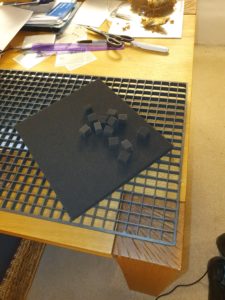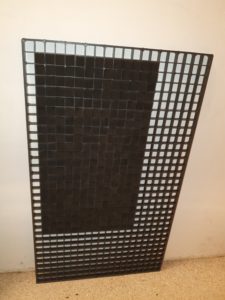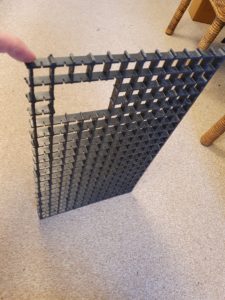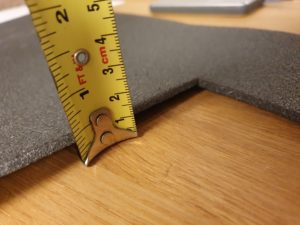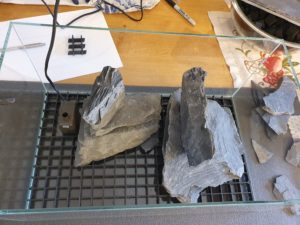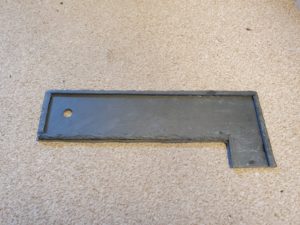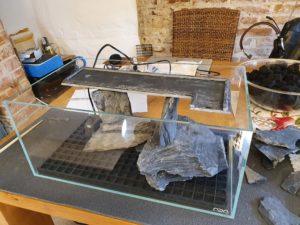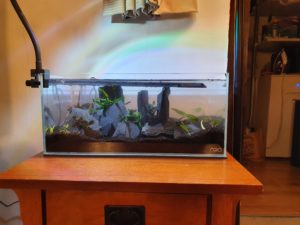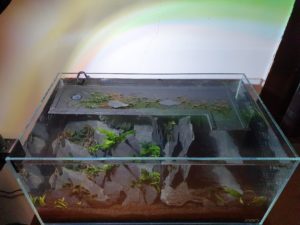Shrimphaus!
Shrimphaus is a ‘low tech’ (no injected CO2 gas) shallow tank designed to support shrimp and also both submersed and emersed plant growth. The aquarium is an ADA Cube Garden 45-F model made from ultraclear low-iron glass with near invisible silcone seams. The tank measures 45 cm wide by 27 cm deep by 20 cm high for a nominal volume of 22 litres. The overall ecological philosophy is informed by Diana Walstad’s classic text “Ecology of the Planted Aquarium”.
Hardscape base and passive filtration system
Placed on the bottom floor of the aquarium is a removable polypropylene grid 15mm thick consisting of individual squares just smaller than 20mm x 20mm. A cut out a hole lets the pump sit flushly on the aquarium bottom glass, and notches several millimetres deep were cut into each side of all the grid squares to allow water communication in all lateral directions, at least to some extent. Each square in the grid was stuffed with a pre-wetted 2cm x 2cm x 15mm cube cut from a medium density air filter foam sponge originally designed for motorcycle engines. The idea is for beneficial bacteria to colonise the foam squares and for water to be drawn slowly through the gridded filtration system by the pump. The actual flow of water through the foam may be very low and so passive diffusion might be the most relevant means of exchange between the water column and the foam grid base.
The aquarium rests on a 4mm thick Aquael safety base mat. Inside the aquarium and resting on the polypropylene grid filtration system, the hardscape is the better part of 10 kg of slate pieces and fragments. In some cases large slate pieces were broken down to size using a sledge hammer. Two centrally supportive slate columns are formed from slate pieces that fit well together naturally and are additionally held stable with Gorilla brand Contact Adhesive Clear. The contact adhesive is completely waterproof but does take on a whitish cast after exposure to water.
aquarium aquaduct water flow
Water circulating aquaduct
In order to achieve gentle water circulation across the entire aquarium, water is drawn into an Oase OptiMax 300 pump set on the lowest pumping speed situated in the bottom back left corner of the aquarium. The water outflow from the pump enters a vertically oriented clear PVC tube (13mm ID, 17mm OD) and is transported up to a slate water race style aquaduct that sends the water across the top of the aquarium with final deposition in the top front right corner of the tank. The base of the water race was constucted from a slate cheese serving board cut using a Dremel rotary tool equipped with a diamond cutting wheel. Rails on the aquaduct were similarly cut from the same slate serving board and glued into place with waterproof contact adhesive. The PVC pipe coming up from the pump passes snugly through a 16mm diameter hole that was drilled in the slate using a diamond drill bit and is secured in place, perhaps unnecessarily, with a 3mm thick 16mm diameter nitrile rubber O-ring. The water race sits stably on the slate support structures without needing to be glued in place and can be easily removed if necessary. The entire aquaduct slopes very gently from left to right and directs water flow even if the entirety of the aquaduct is under water.
Completed hardscape and planting strategy
Additional slate fragments are situated around the main slate supporing columns. Tropica Aquarium soil rounds out the hardscape design. The planting strategy is to have underwater ephiphytes such as bucephalandra mounted in the slate fragments. A variety of cryptocoryne species will be planted in the aquarium soil. The aquaduct doubles as a platform for emergent growth plants including mosses and anubias although keeping humidity levels sufficiently high may prove to be an issue. Starter plants will include various bucephalandra species: Kedagang, Red, Mini Catherine, Dark Theia and Sintang; cryptocoryne species: Green Gecko, Affinis and Walkerii; Java moss, Christmas moss and Anubias nana Coin Leaf.
Lighting
Dedicated lighting is provided by an Asta 20 nano LED aquarium light on a timer. There is also considerable ambient room light but no direct sunlight.
How to set up a successful low-tech planted aquarium – reflections on Shrimphaus original design
One year on and we can consider aspects of design that have worked well and not worked well…
Water circulation – success
aquaduct water circulation
I’m very happy with the performance of the aquaduct. This does a great job of circulating water from the bottom left of the tank to the upper right. The flow is vigorous and steady but not too strong. Currently I am running the pump at half speed with a 3-sided slate cap to keep the water from shooting out straight up and instead mostly heading off down the aquaduct. There have been almost no incidents of shrimp getting sucked up into the pump – only one casualty the whole year. Zebra thorn snails can make their way down the outflow tube from the top but have generally found their way back out again successfully – no examples of snails making it all the way down into the pump itself.
Passive filtration system – mixed
If I’m honest, I’m not sure the passive filtration system is doing much of anything. I’m pretty sure the water flow through the foam is minimal or absent. When I dismantled the Shrimphaus for the rebuild the foam seemed in pretty new condition without a lot of organic anything to it suggesting it is not doing much in way of providing a support matrix for beneficial bacteria. That being said, I don’t think the passive filtration system has hurt anything, and it’s good the hardscape is up off the glass on the bottom of the tank. Arguably the 1 cm depth of the polypropylene grid is excessive. If I were to do it again I’d try to find a grid that is 5 mm thick to regain a little vertical space and maybe not bother with the foam squares which were a lot of work to cut out and fit in – using some small foam spheres to fill in the spaces in the grid could have been a lot easier.
Hardscape design – fail
Other than the successful aquaduct, the idea of having a lot of vertically oriented slate slabs as surfaces for epiphytes turned out to be a terrible idea. These created impossible to clean dead spaces which led to a build-up of organic waste and eventually Shrimphaus 1.0 being overrun with black beard algae. In retrospect, it does seem like aiming for a lot of vertical surfaces in a fundamentally shallow tank like the ADA 45-F is trying to fight against the inherent geometry of the set-up. Vertical makes a lot more sense in a tank like the Fireplace Aquarium that is taller than it is wide where a hardscape structure like the mountain can provide a nice vertical surface for epiphyte growth.
Planting strategy – mixed
The epiphytes did not work very well – they may have done better if glued onto horizontal supports. That being said, the submersed crypts, mosses and ferns have been reasonably successful. Getting plants, specifically anubias and bucephalandra species to grow in emersed form in the river has mostly not worked, although the Anubias gracilis is still having a bit of a go at it. I’m going to keep trying there. Trying to grow aquatic moss in the river did not work at all, maybe terrestrial moss would have been a better choice. I’ve considered maybe some dwarf irises and I’ve just now got in an extra pot of Cryptocoryne petchii pink and might see how that does. I am very happy with the look of the submersed Alternanthera reineckii ‘Mini’ – that is working out really well so far.
Lighting – success
I have the Asta 20 nano LED light operating on 20% power and that seems to be plenty bright enough for the whole front of the aquarium. The aquaduct does make the back of the aquarium pretty shady but so far the moss is working out and there is also a small crypt in the back right corner that has managed to pretty much hold its own for the year. There was some weird flickering from the Asta 20 shortly after it was first installed such that I thought of getting rid of it, but for some reason it stopped doing that and has been essentially well-behaved over the year – no complaints. The gooseneck mount is attractive and I do like the look of this light on the tank.
Other bits and pieces…
It quickly became apparent that biofilm on the water surface was going to be an issue even with good water circulation from the aquaduct. An airstone bubbler in the centre of the tank sorted that all out straight away.
See also: Shrimphaus 1.0 – lessons learned
